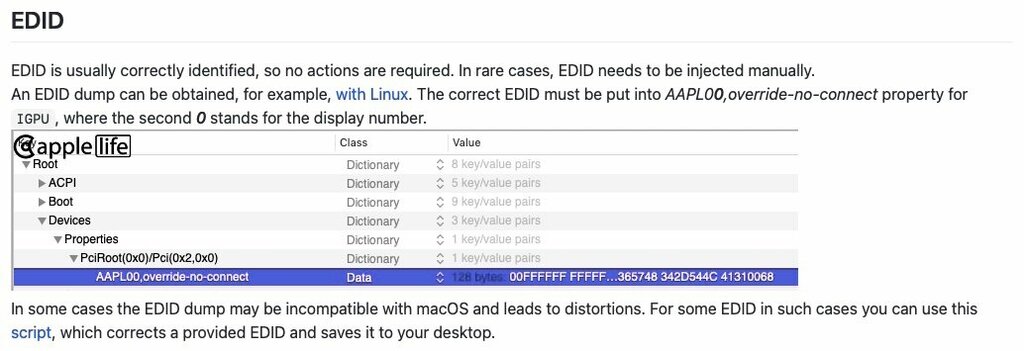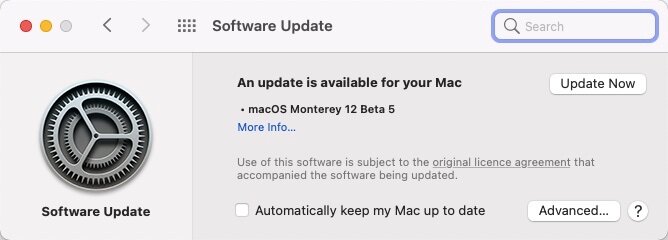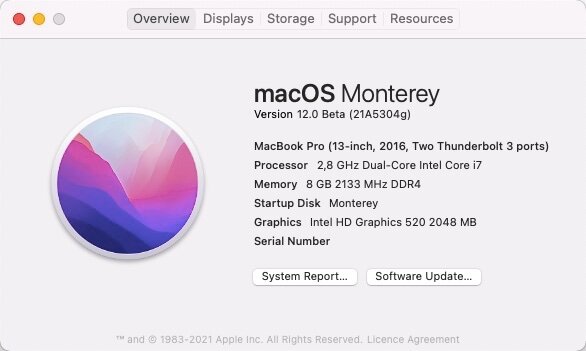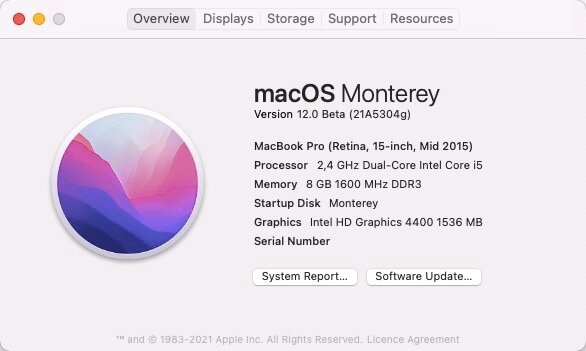-
Posts
10068 -
Joined
-
Last visited
-
Days Won
569
Content Type
Profiles
Articles, News and Tips
Forums
Everything posted by Hervé
-
Would not open in OCC or ProperTree at my end but there's seems to be an issue with OC version anyway so clarification required.
-
Your posted OC config file appears corrupt...
-
Please search the forum before posting. Thank you. https://osxlatitude.com/forums/topic/10263-older-broadcom-cards-eg-bcm431x-unsupported-since-sierra https://osxlatitude.com/forums/topic/11138-inventory-of-supportedunsupported-wireless-cards-2-sierra-big-sur
-

Dell Precision 5510: Unable to use 4k built-in screen
Hervé replied to lamatta17's topic in Precision x000 Series
Note that EDID's hexadecimal data must be entered without any spaces. They'll just automatically pop out afterwards. -
Re: HD3000 VRAM, default behaviour in OS X/macOS is to allocate VRAM according to the amount of RAM fitted to the computer. https://support.apple.com/en-us/HT204349 If you want to allocate more VRAM, you can apply patches to the SNB kexts though there is very little to gain; certainly nothing from a performance point of view (HD3000 is a pretty poor iGPU) and it won't fix the memory leak bug that causes horizontal lines and artefacts across the screen over time, merely slow it down a little (only solution is to reboot). You'll find details of the VRAM patch in this thread at IM or in the Clover config I posted in my most recent E6220 guides (High Sierra and later). Reading through the IM thread, you'll find that there's no gain to be obtained past 1024MB of VRAM. Re: RAM, it's a little confusing because you entitled your thread with 4GB RAM and specified that in post #1. However your initial screenshot showed 8GB and you seem to state that you get 512MB VRAM allocated by default as is the case with 8GB RAM. If your laptop is only fitted with 4GB or RAM, I certainly would not go beyond 512MB for HD3000 VRAM ,for obvious reasons. If you have 8GB, yes you may allocate 1.5 or 2GB VRAM but, as stated above, 1GB really is sufficient.
-
Coming from Sierra (or earlier), many of us initially experimented or started with High Sierra in legacy HFS+ mode given that APFS was new and did not work extremely well on mechanical HDDs. However, as time passed and more users ran on SSDs, the installation in APFS mode gradually generalised. But rest assured that opting for no conversion works well and you can safely go for that. Subsequent macOS versions no longer offer this and APFS is sole standard mode. Running Mojave and later on HFS partitions requires tricks that are best avoided imo.
-
1st of all, identify all your hardware specs. Then, you have no graphics acceleration, you missed that essential part... You have to install any Catalina versions past 10.15.3 with dosdude1's patcher. Your laptop will be kind of unusable without graphics acceleration. Then, after any Catalina update, you have to re-patch the system again; last time I checked, this could be most awkward/difficult with dosdude1's patcher but things may have evolved since. You may check that out at MacRumors where they have a dedicated thread for Catalina on unsupported platforms. Any Sandy Bridge/HD3000 platform falls into that category.
-
1st of all, post your specs so that we can ascertain your own situation, especially for wireless. You may also want to have a look at my E7270 guide to compare settings. I encounter none of the issues you've listed but I use far less kexts and a few more patched SSDTs of course. HDMI output always worked OOB for me (with the behaviour detailed in my guide) and I've only injected HDMI port type in order to gain HDMI audio output. Screen brightness works with SSDT-PNLF. Brightness keys work with the associated config settings + patched SSDT as detailed in a few posts and guide I posted. Can't see why you'd lose wireless after wake but Jake's EFI folder appears to inject properties for a DW1820A and you may not have such a card.
-
Looks like after registering in 2013, you were last a little active on the forum in 2017 until you returned today. You must have missed our site revamps of spring 2018 and end 2020.
-
I've re-enabled RSS with the following feeds: News & Articles (for News/Articles/Guides we post on OSXL Home page) Latest Topics (for last 10 new topics) Any other feed would be old/defunct/cached stuff and not subject to any update.
-
I'll see if we can re-enable some feeds.
-
I don't know what you're trying to say here... We publish news and articles whenever we have info to share but we've no active RSS feeds that push info out.
-
We've not had any RSS feeds for years...
-
Situation and behaviour regarding Optimus: disabled -> laptop runs on nVidia dGPU only. enabled -> laptop runs on Intel iGPU and nVidia dGPU; dual GPU switching mode on (but unsupported in OS X/macOS). Trouble is that Fermi chips such as the NVS 5200M have no proper support to no support at all in macOS since High Sierra. The buck stopped at Sierra. As such, you can only run Catalina on the Intel HD4000 iGPU. Given that Optimus has to be enabled to that effect, you need to disable the dGPU through ACPI patching in order to prevent it from draining on the battery unnecessarily. Your config shows that you correctly opted for the HiRes Capri Framebuffer 0x01660004 which is required for your HiRes screen 1600x900. This HiRes Framebuffer only offers 1 x video port by default for LVDS/eDP built-in screen so you'll also have to inject additional properties if you ever want to use external monitors (DVI, HDMI, DP; VGA unsupported). You'll find all the necessary details in the dedicated thread to HD4000 graphics available in our R&D->Graphics section. I also noticed you also opted for MBP11,1 SMBIOS; this is a Haswell model that does not require the -no_compat_check boot arg so you could delete that. The boot arg would only be necessary if you opted for an Ivy Bridge model such as MPB9,2 or MPB10,2. You'll also need additional ACPI tables/parameters in your config to trigger support for your keyboards brightness keys; you'll find all the necessary details in my E6230 guide.
-

Dell Precision 5510: Unable to use 4k built-in screen
Hervé replied to lamatta17's topic in Precision x000 Series
You may try and extract your screen's EDID from Windows/Linux, then inject it into macOS through properties passed through your boot loader's config. https://github.com/acidanthera/WhateverGreen/blob/master/Manual/FAQ.IntelHD.en.md -
No and what you have tried appears to be ThinkPad-specific and therefore unsuitable/not-applicable to your Latitude E7470. DrHurt's and its derivative kexts do trigger proper TrackPad detection in PrefPane and some multi-finger gestures. The major trouble is that, with these kexts, TrackPad dies after wake. https://osxlatitude.com/forums/topic/8285-refined-alps-touchpad-driver/ https://osxlatitude.com/forums/topic/8285-refined-alps-touchpad-driver/page/69/?tab=comments#comment-77013 https://osxlatitude.com/forums/topic/10673-solved-can-e7270-patch-for-3-and-4-finger-working-on-trackpad So, afaik, from a stability and proper usage point of view, the best you can get on the E7x70 to date is basic Trackpad mouse-like functionalities and 2-finger scrolling. See my E7270 guide.
-
No no no! Leave /S/L/E full vanilla/untouched. Place copies of Lilu + AppleALC (not AppleHDA !) in Clover's kexts folder. Remove VoodooHDA from wherever it is. If it's in /L/E and/or in /S/L/E, rebuild your cache after you delete it. Remove or disable the AppleHDA patch found in your Clover config.
-
Your sleep issue results from using VoodooSDHC; it breaks sleep so I can only advise you to get rid of this kext. Your posted IOReg shows PCI id 1180,822 for your SD card reader (ACPI device CDR2@1,2) so it's a Ricoh R5C822 model as stated in the associated properties patch seen in your DSDT. I'm not sure it'll work but I invite you to try the property injection detailed here for the card reader. You can either inject the compatible property through your Clover config or by adding it to the existing DSDT patch. Note that this particular SD card reader certainly used to work under old versions of OS X like Leopard/Snow Leopard (eg: Dell Inspiron 6000) through add-on kext IOSDHCIBlockDevice kext. There were updated 64bit versions of that kext so you could try it after patching its Info.plist file for that Ricoh card reader. https://www.insanelymac.com/forum/topic/286224-iosdhciblockdevicekext-driver-for-jmicron-sd-card-readers-for-107108/ Re: audio, your Clover setup shows that you re-use a patched DSDT from an E6400; it's probably fine from a system's point of you (the M4400 being an E6500 with upgraded Tesla dGPU) but it injects properties that are meant for AppleHDA. If you keep those properties, I would experiment with Lilu + AppleALC and remove the AppleHDA binary patch I saw in the Clover config. If you opt for VoodooHDA, you should also use AppleHDADisabler and you may need to remove the audio properties injected through DSDT. You may also want to revise the IRQNoFlags statements configured for HPET ACPI device and change them from 2/8/11/15 to 0/8/11/15.
-
Disable hibernation as detailed in our FAQ forum section.
-
No help possible until you specify what computer you're talking about and provide the specs. Opening a thread entitled "help needed" with such absence of information is not suitable and would normally just be deleted.
-
These are Chameleon/Enoch boot args so not applicable to Clover or OpenCore if you're using one of those. So, please: post your system's specs specify which bootloader and bootloader version you're using attach a zipped version of your bootloader folder (EFI for Clover/OpenCore, Extra for Chameleon/Enoch) Your issue is indeed USB-related so you could try and boot off other USB ports but make sure you're using USBInjectAll kext. Of course, don't re-use any patched DSDT that comes from a different model.
-
I don't believe anyone posted a High Sierra guide (or any other version to that effect) for the Precision M4400 model in our Guides section. However, you may follow the process detailed in any existing High Sierra guide published in the aforementioned section. You'll just have to adjust the part relating to the pack by using the package you found. Given that the M4400 is an old late-Penryn C2D (FSB 1066MHz) laptop, you can have a look at my Latitude D630/D830 (nVidia) guides for High Sierra or any such guide for the E6400/E6500 (nVidia). The Precision M4400 is effectively a Latitude E6500 with a more powerful Tesla dGPU. Please post your full system's specs if you need further assistance.
-
5th beta released August 11th, 2021. Build 21A5304g. Ok on my Latitude E7270 (Clover r5133) and Satellite Pro R50-B (OC 0.7.0).
-

[Solved] E5440: stuck on "apfs_module_start: 1689"
Hervé replied to travis_de's topic in The Archive
That EFI folder does not appear to use/inject SSDT-PNLF table which, by far and large, is necessary to obtain brightness control. After you've added that table and rebooted/reset NVRAM, check if your Display PrefPane presents the brightness control bar or not. It should. Once you've asserted you have brightness control, your keyboard brightness keys may not be operational but other keys/key combinations probably will. You mar refer to this guide to remap brightness control keys. -
As stated in my previous reply: EDP was OSXLatitude's own post-install tuning tool. It had nothing to do with bootloading. After its demise back in 2014/2015, fully tuned bootpacks were provided as replacement. References to EDP have now been removed from all those ML with MLPF guides for the old D Series





